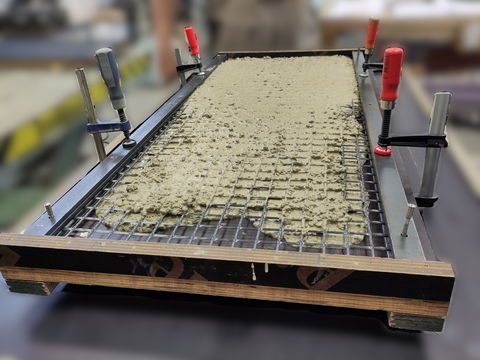Practice-oriented ready-mixed concretes for CRC
Table of contents
Projektdaten
| Titel | Title Entwicklung praxisgerechter Transportbetone für carbonbewehrte Ortbetonbauteile (ReadyCarbonCret) | Development of practice-oriented ready-mixed concretes for carbon-reinforced in-situ concrete components (ReadyCarbonCret) Förderer | Funding BMWK, AiF/IGF Zeitraum | Period 01/2023 – 04/2025 Projektleiter | Project leader Prof. Dr.-Ing. Steffen Marx Team | Team Dipl.-Ing. Peter Betz, Dipl.-Ing. Jenny Pech Projektpartner | Project partner F. A. Finger-Institut für Baustoffe, Bauhaus-Universität Weimar |
Report from year book 2023
Ready-mix concrete for carbon-reinforced concrete

Concreting the tension test specimens
At present, new carbon-reinforced concrete components are currently mainly produced in precast plants and research laboratories, which guarantees a high level of production accuracy and therefore a consistent material quality. Suitability testing in accordance with the requirements of the ready-mix concrete industry has not been the focus of research and development in recent years. With the development of new carbon fiber reinforcements and the growing experience in handling carbon-reinforced concrete, the focus is increasingly shifting to in-situ concrete applications in new and existing buildings.
The aim of the research project “ReadyCarbonCret” is to demonstrate the practical suitability of carbon-reinforced concrete for in-situ concrete components. The ready-mix concrete industry is actively involved in the project. The Institut für Baustoffkunde at Bauhaus-Universität Weimar is responsible for preparing the mix designs and evaluating the fresh and hardened concrete properties of three different exemplary concretes. Due to the need to drastically reduce greenhouse gas emissions in the construction sector, the mix designs will be developed with clinker-reduced, standardized, or approved binder systems.
Based on the mix designs found to be suitable, the influence on the specific properties of the composite carbon-reinforced concrete is evaluated at our Institute of Concrete Structures of TU Dresden. For this purpose, two carbon fiber reinforcements with different geometries and impregnations will be used. The investigations of the bond properties between concrete and carbon fiber reinforcement are based on experience from previous projects. In addition to the tensile strength of the composite material in tension test, the bond behavior will be determined in single-sided pull-out and in overlap joint tests under uniaxial tensile loading.
The test specimens are currently being manufactured and tested under laboratory conditions. In a second working package, the concrete mixtures will be produced in a selected ready-mixed concrete plant. The fresh concrete properties will be tested at two different processing times and specimens will be produced to determine the hardened concrete properties and the carbon-reinforced concrete specific bond parameters. The knowledge gained will be validated on a demonstrator at the end of the project.
Short description
New building components made of carbon-reinforced concrete are currently mainly produced in precast factories and research laboratories, which can guarantee high production accuracy and thus constant material properties. With the development of more robust carbon-fiber reinforcements with larger cross-sections and bar spacings and the increasing experience in handling carbon-reinforced concrete, the applications with in-situ concrete in new and existing buildings are now coming into focus. The requirements are changing for in-situ concretes. More robust mix compositions and raw materials are demanded. The concrete must be pumpable and allow a significantly increased workability time. At the same time, the mostly fine-grained carbon grid reinforcement results in the necessity to use concretes that are particularly easy to place and process.
The objective of the research project is to demonstrate the practical suitability of carbon-reinforced concrete compositions for in-situ concrete components based on ready-mixed concrete. With regard to a drastic reduction of greenhouse gas emissions, the development of mix designs with clinker-reduced, standard or approved binder systems is carried out. The findings will be validated on a demonstrator. The results of the project will be transferred to the current standardisation work on carbon concrete.
By achieving the project goals, a significant economic and social contribution will be made with regard to resource efficiency and the reduction of carbon emissions in the construction industry. In addition, the extension of the carbon-reinforced concrete construction method to in-situ concrete construction offers an expansion of the existing business fields of ready-mixed concrete manufacturers as well as companies in the concrete conveying industry and thus leads to an increase in the competitiveness of small and medium-sized companies in these industries.
